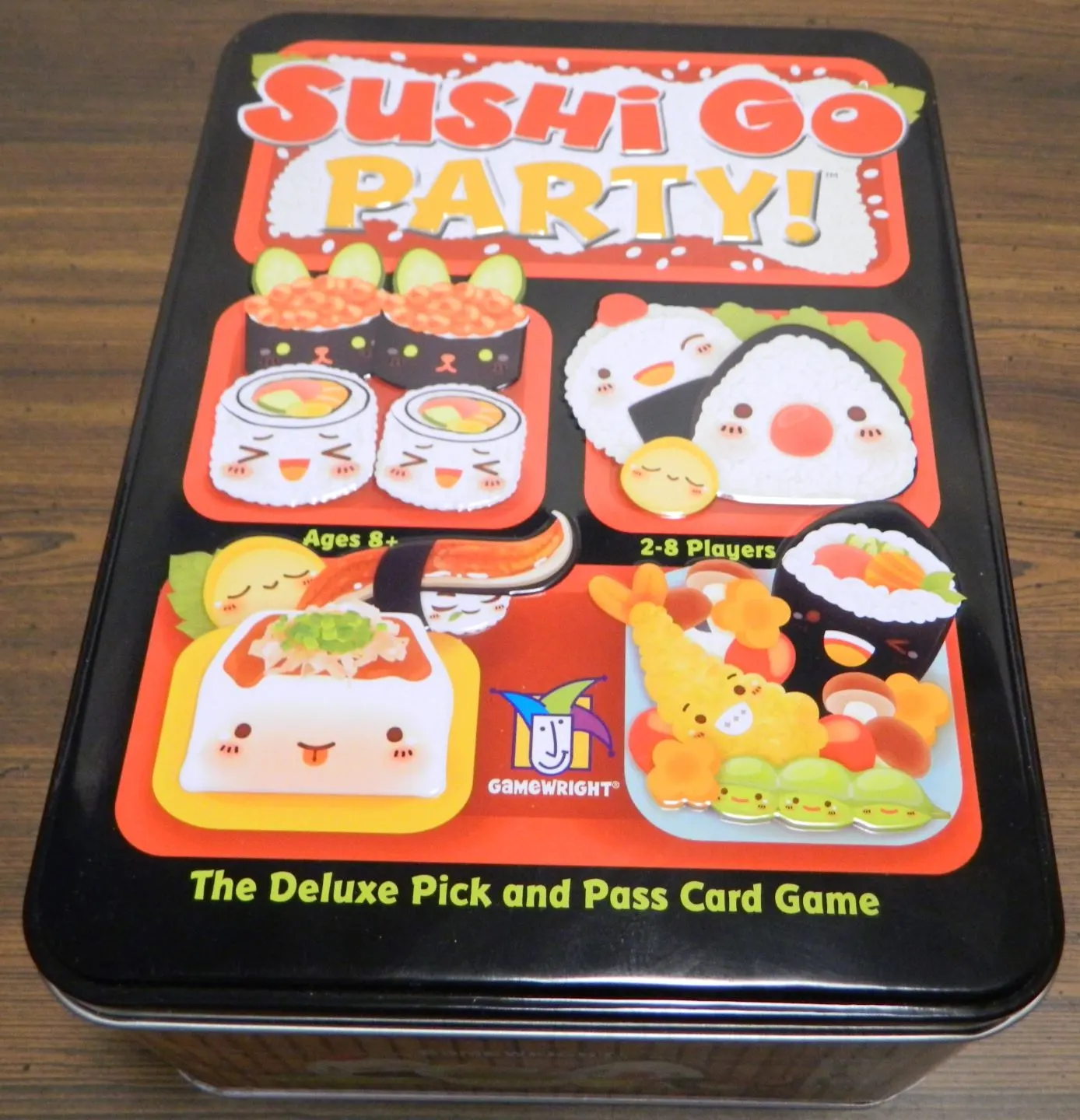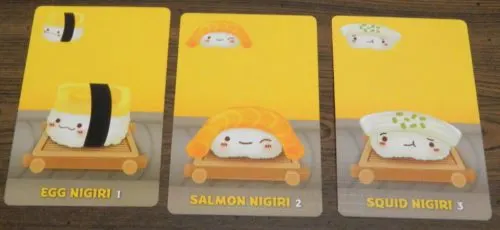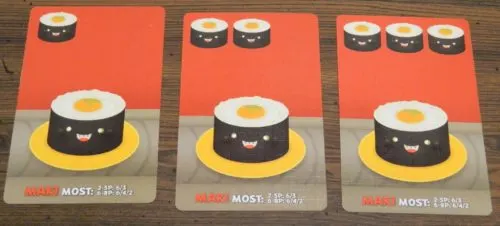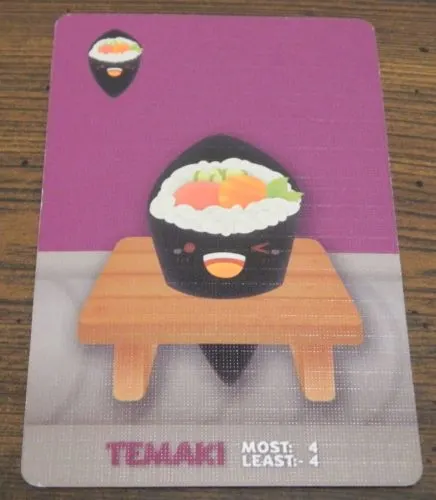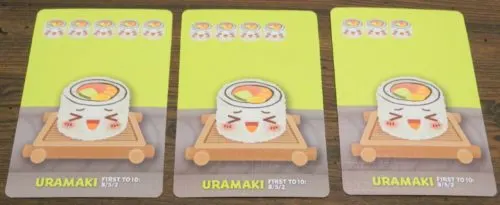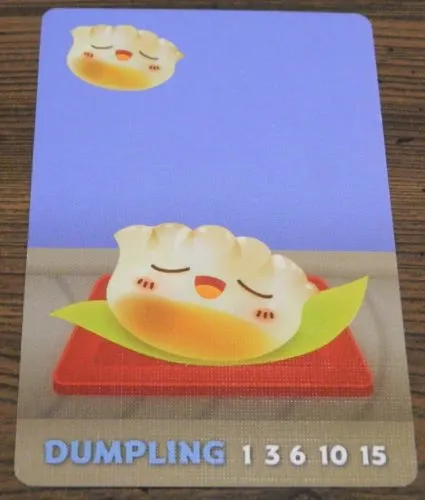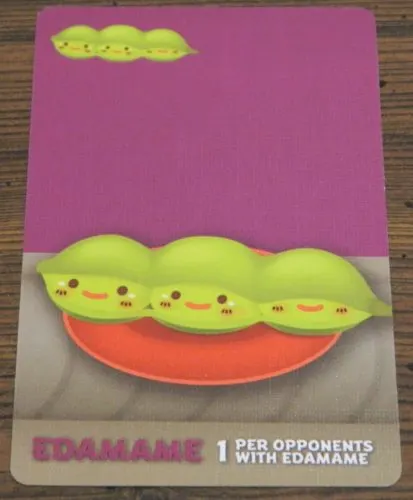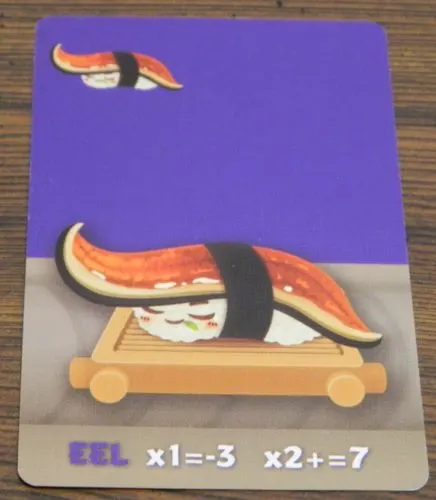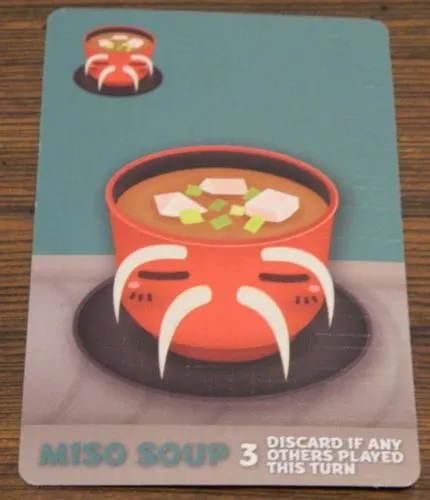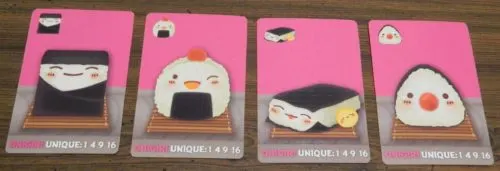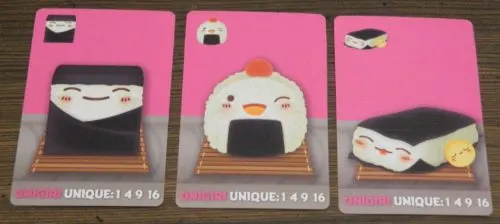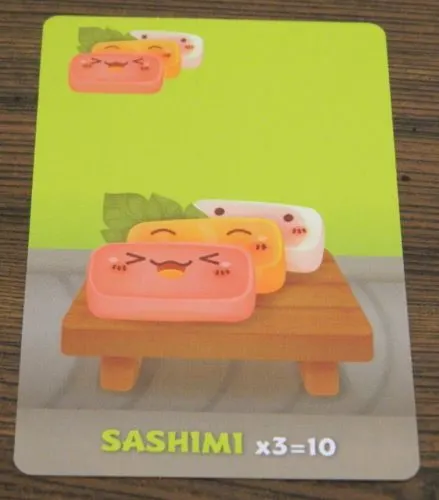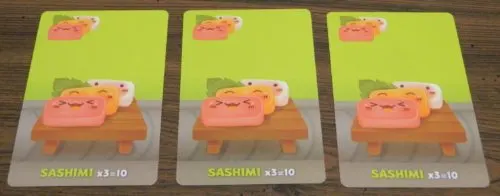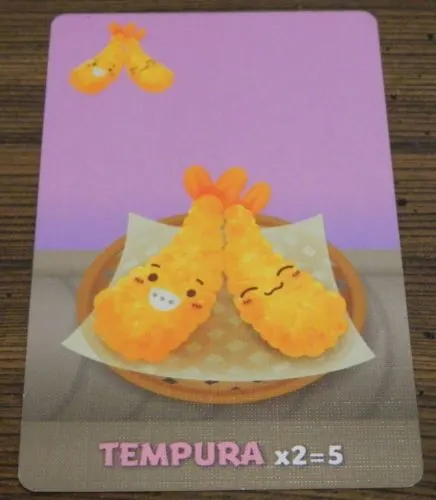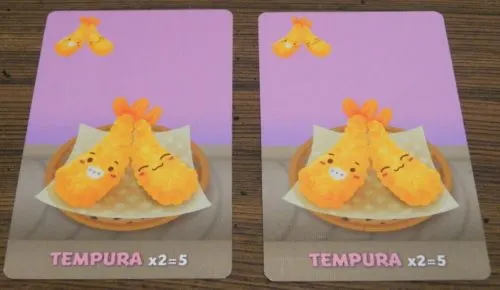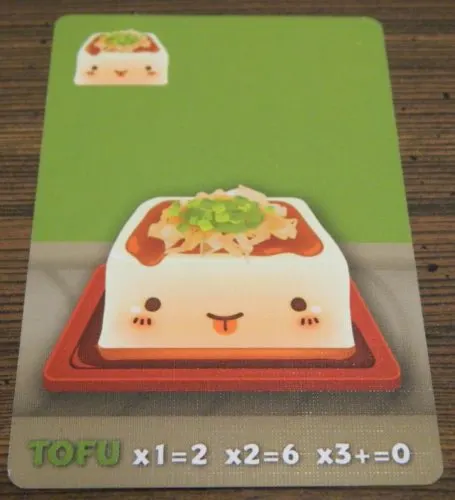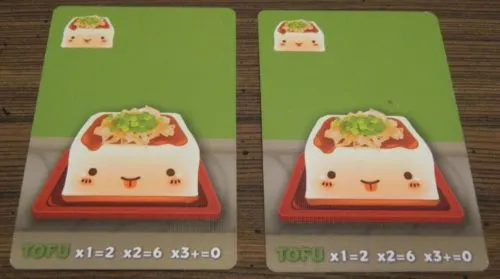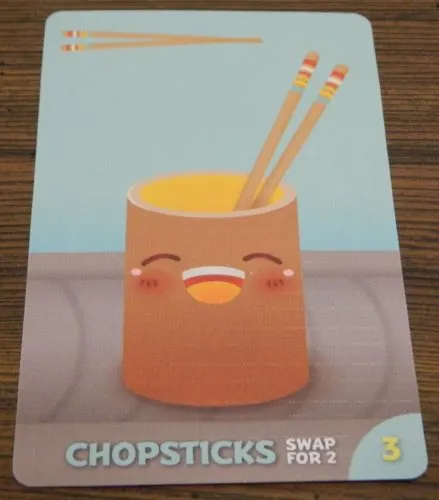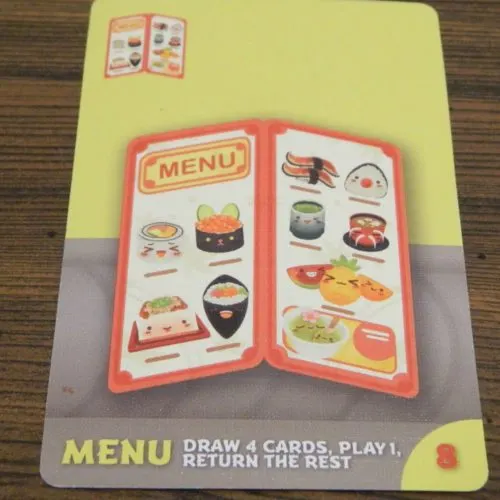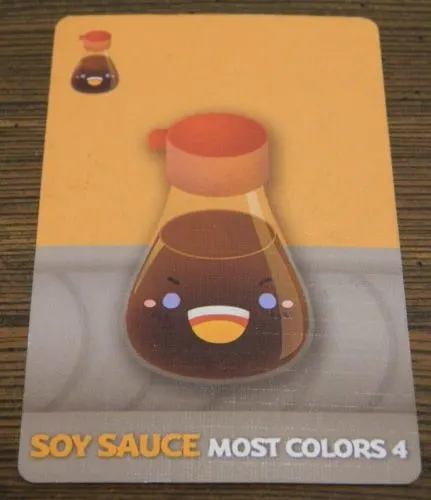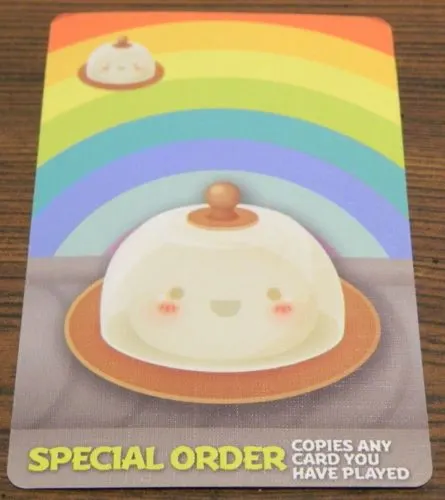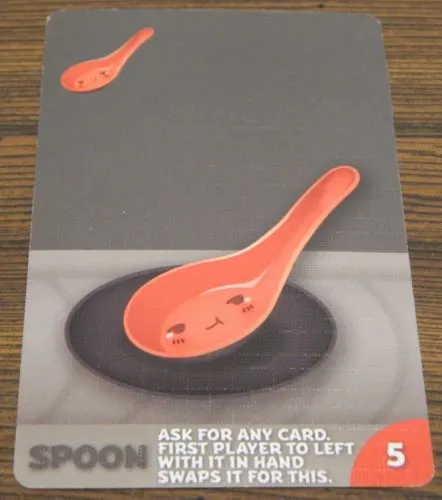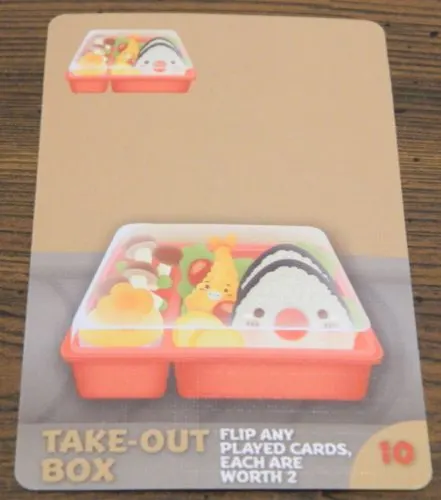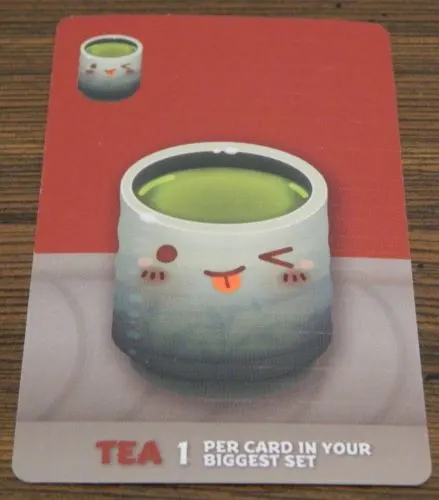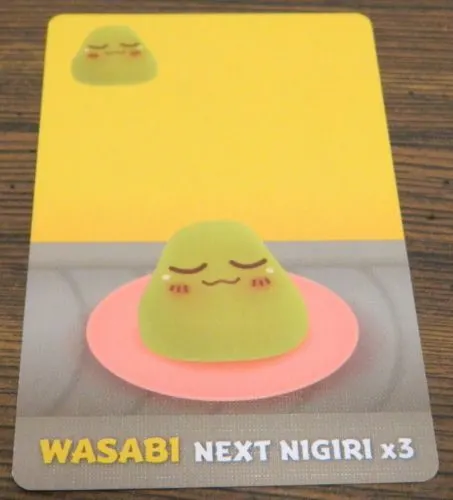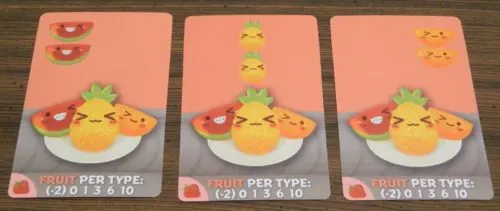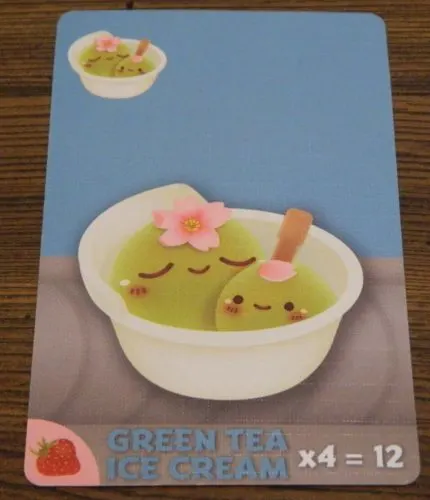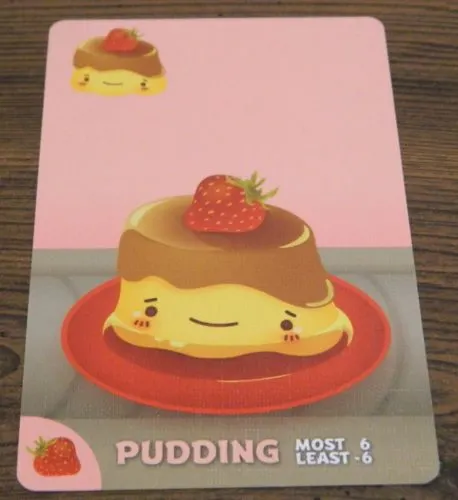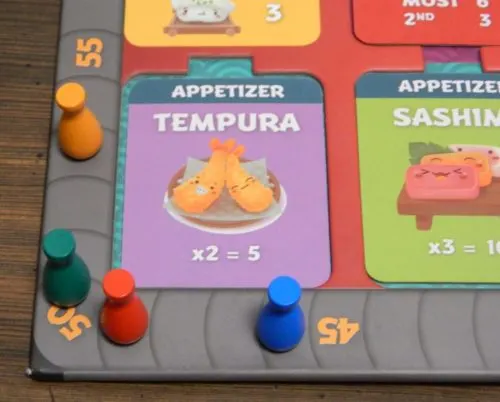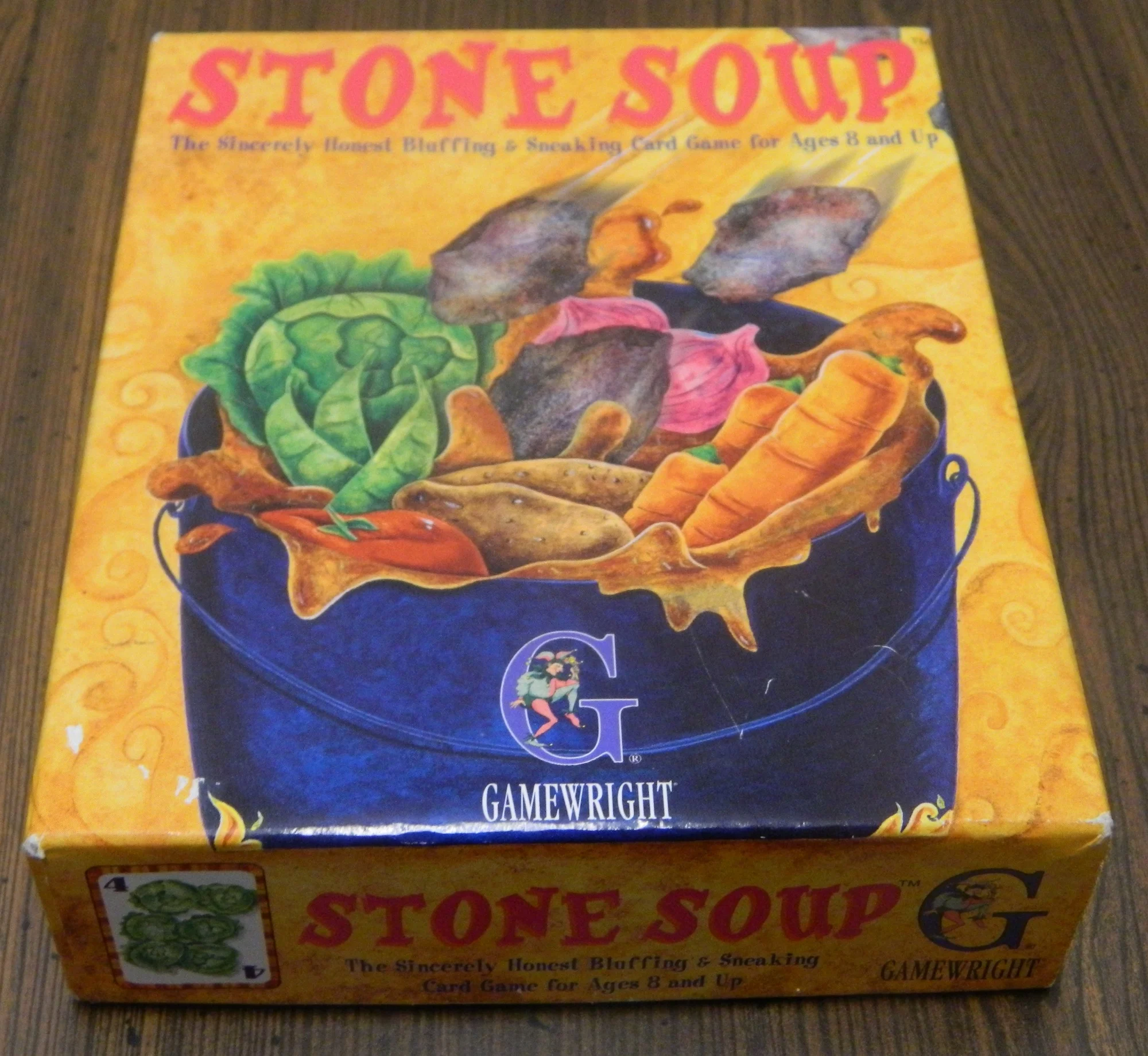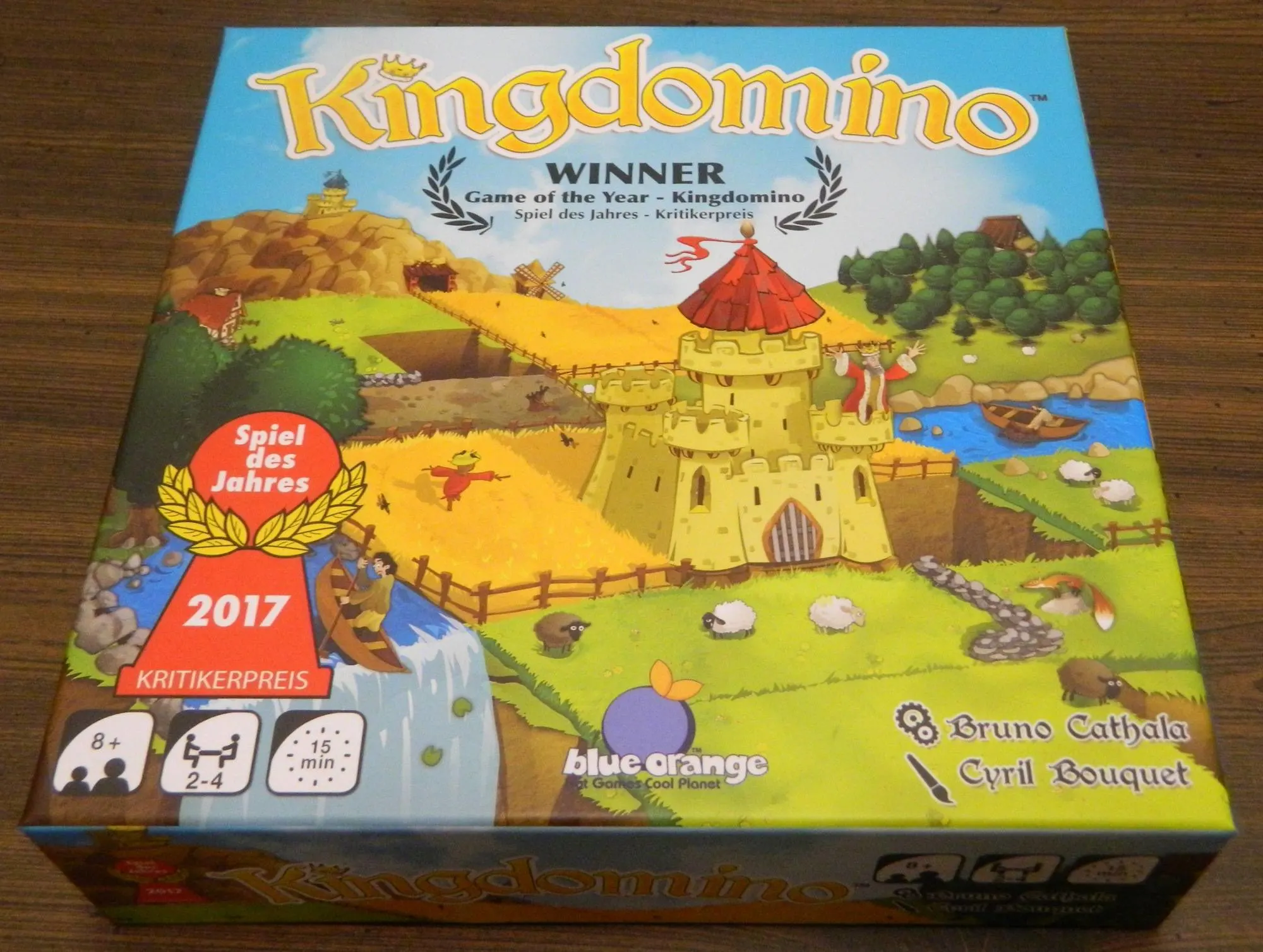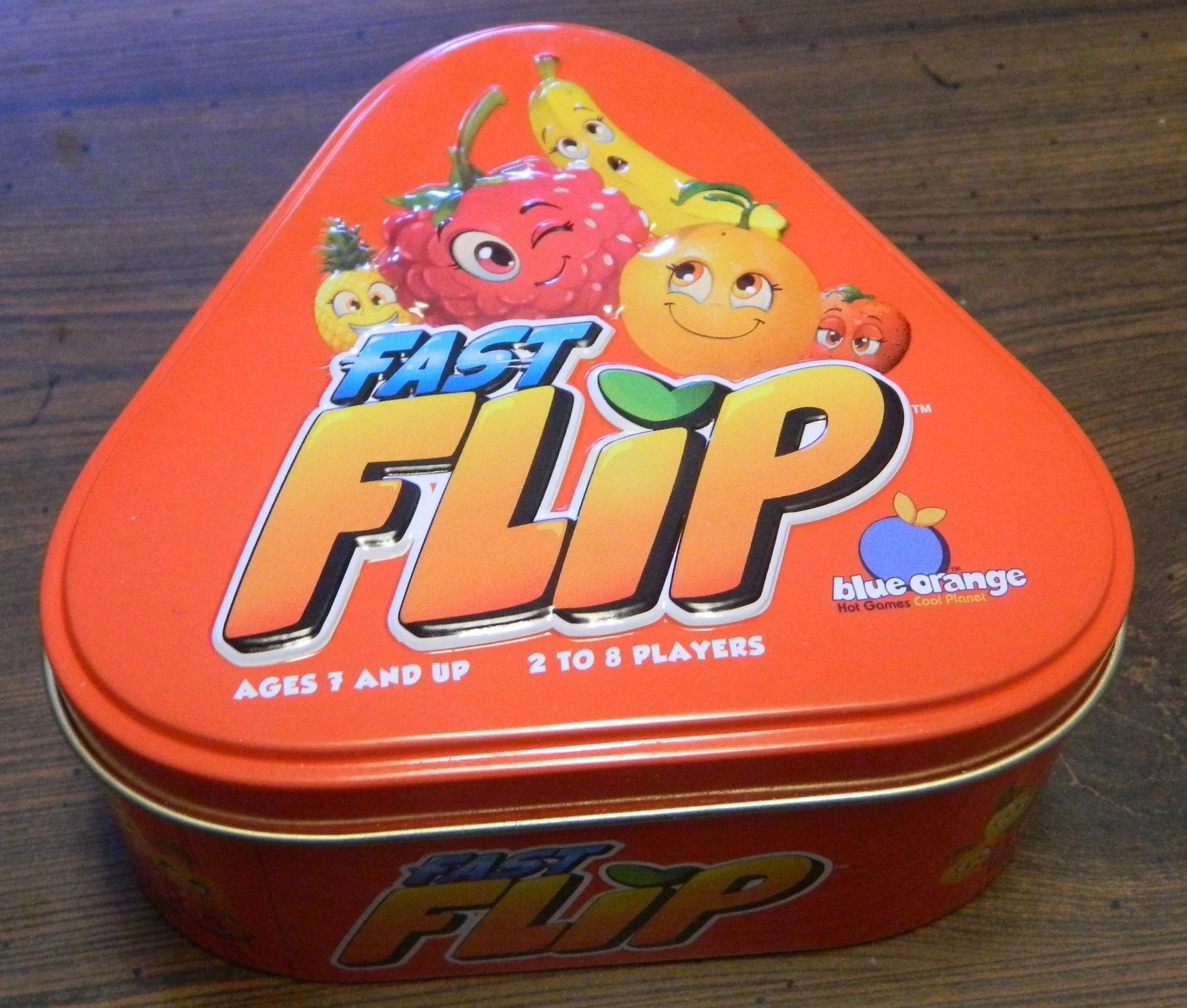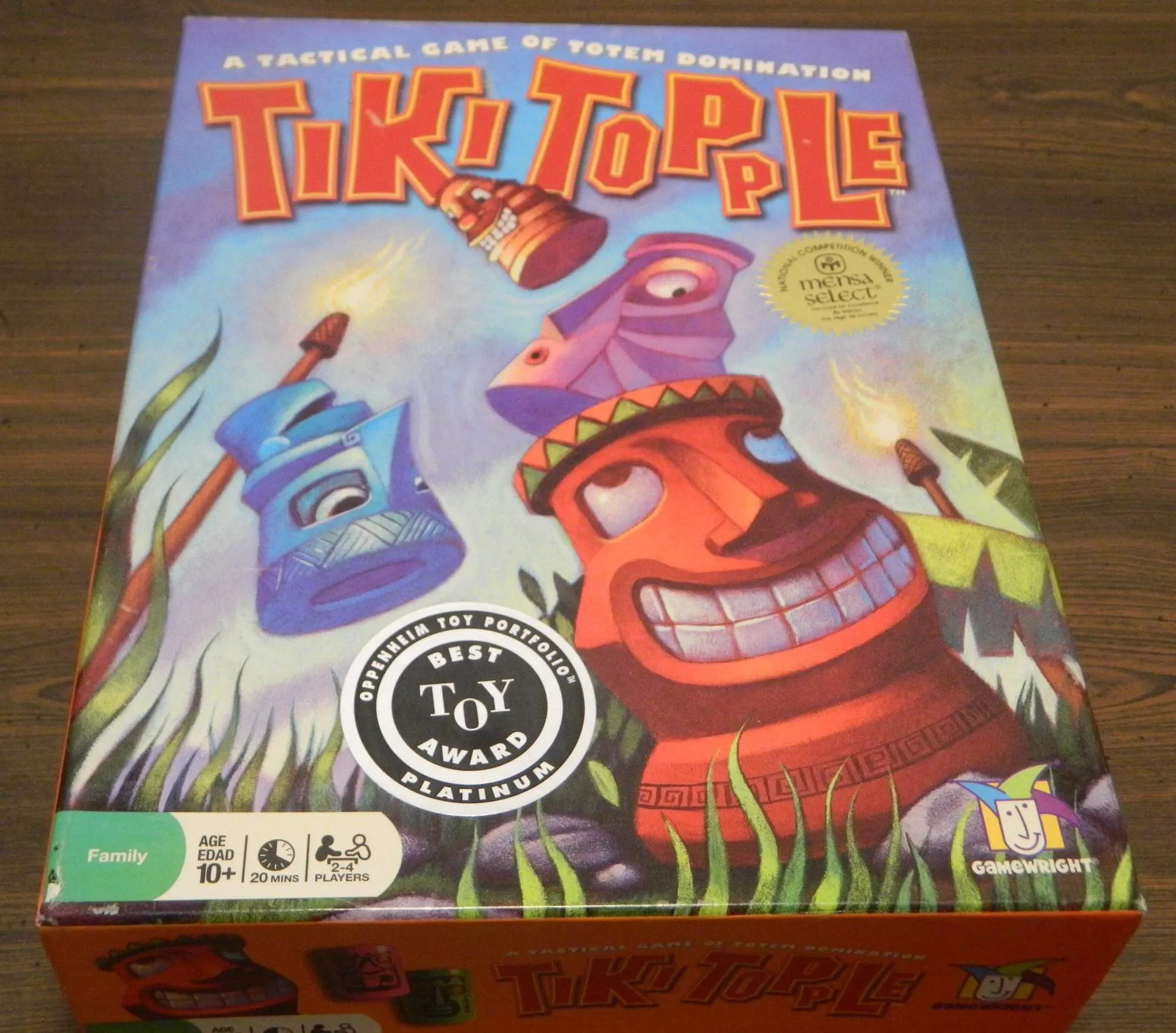Around four years ago I checked out the original Sushi Go!. While I had high expectations for the game it successfully met them and in some ways exceeded them. On the surface the game might look like your typical set collecting card game, but it is much more than that. The game succeeds because it finds the perfect balance between accessibility and strategy. With how much I enjoyed the original game I was really interested in checking out its sequel/spinoff Sushi Go Party!. Sushi Go Party! is basically the next iteration of Sushi Go! as it includes everything from the original game while adding in considerably more types of cards to add a lot more variety to the game. Sushi Go Party! is exactly what you want out of a board game sequel as it takes everything good about the original game and makes it bigger and better.
How to Play Sushi Go Party!
Setup
- Place the gameboard in the center of the table.
- Each player chooses a color playing piece and places it on the zero space.
- The players will choose a menu of cards that they would like to use for the game (see below).
- Find the menu tiles for the cards you chose to use and place them in the corresponding spots on the gameboard.
- Shuffle the chosen dessert cards if you chose fruit. Place the dessert cards face down in a pile to the side of the gameboard.
- Take all of the other chosen cards and shuffle them together to form the game deck.
Choosing A Menu
Before you begin the game you must choose a menu of food items that you will use in the game. The players can choose one of the following menus or create their own. If the players choose to make their own menu they must choose the Nigiri, one type of rolls, three types of appetizers, two types of specials, and one dessert.
- My First Meal: nigiri, maki, tempura, sashimi, miso soup, wasabi, tea, green tea ice cream
- Sushi Go!: nigiri, maki, tempura, sashimi, dumpling, chopsticks, wasabi, pudding
- Party Sampler: nigiri, temaki, tempua, dumpling, tofu, wasabi, menu, green tea ice cream
- Master Menu: nigiri, temaki, onigiri, tofu, sashimi, spoon, takeout box, fruit
- Points Platter: nigiri, uramaki, onigiri, dumpling, edamame, special order, tea, green tea ice cream
- Cutthroat Combo: nigiri, temaki, eel, tofu, miso soup, spoon, soy sauce, pudding
- Big Banquet: nigiri, maki, tempura, dumpling, eel, spoon, chopsticks, green tea ice cream
- Dinner for Two: nigiri, uramaki, onigiri, tofu, miso soup, menu, special order, fruit
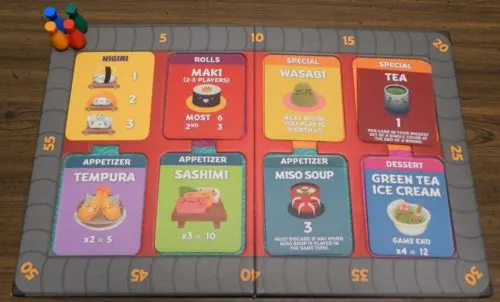
The players have chosen to play the “My First Meal” menu. They have found the corresponding tiles and placed them in the board. They have also found the corresponding cards.
When choosing a menu or creating your own there are a couple rules. You may not use menu or special order cards in 7-8 player games. You also may not use the spoon or edamame cards in two player games.
Stating A Round
Sushi Go Party! is played over three rounds. Before you begin each round you must do the following.
First you will add dessert cards to the game deck and shuffle the entire deck together. The number of dessert cards that you will add depends on the number of players and the current round as shown in the table below.
| 2-5 Players | 6-8 Players | |
|---|---|---|
| Round 1 | 5 | 7 |
| Round 2 | 3 | 5 |
| Round 3 | 2 | 3 |
After the cards have been shuffled you will deal cards face down to each player based on the number of players:
- 2-3 players: 10 cards
- 4-5 players: 9 cards
- 6-7 players: 8 cards
- 8 players: 7 cards
The remaining cards in the game deck will be placed face down next to the gameboard. Each player will then pick up the cards dealt to them and look at them without letting the other players see them. The round then begins.
Playing the Game
On each turn all of the players will look at the cards in their hand. Based on their strategy and the cards they have taken in the past each player will choose one of the cards from their hand and place it face down on the table. When all of the players have chosen their card each player will reveal their card by turning it face up and keeping it in front of them for the rest of the round.
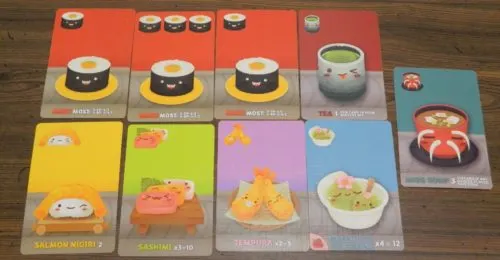
A player has been dealt this hand at the beginning of a round. They will choose one of the cards and pass the rest of the cards to the player on their left.
Each player will then pass the cards remaining in their hand to the player to their left. Players will then choose a card from this new hand and follow the same process as above. This continues until all of the cards have been taken by the players.
The players will then score the cards that they collected during the round. All dessert cards that are taken during the round are set aside as they are scored at the end of the game. Each type of card is scored differently which can be found in the Cards section below. The players will score each type of card and move their pawn forward the corresponding number of spaces.
All cards taken during the round other than the dessert cards are then collected and added to the game deck. The next round will then begin. Once three rounds are over the game moves to final scoring.
Cards
All of the different types of cards in Sushi Go Party! have their own special abilities or scoring conditions which are described below. The cards are listed by their types.
Nigiri
Nigiri cards are worth points equal to the value printed on the card. If a wasabi card is played on a nigiri card it will be worth three times as many points.
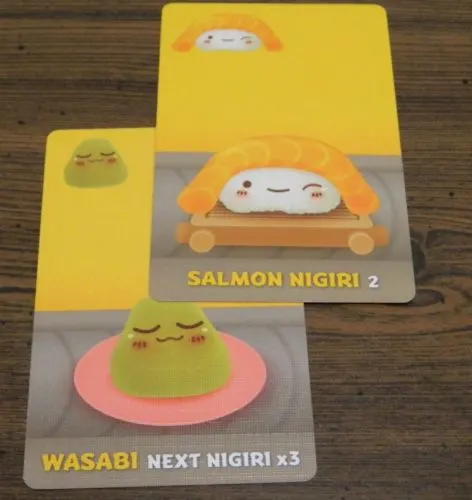
This player acquired a wasabi card on a previous turn. This turn they acquired a salmon nigiri. The salmon nigiri will be worth six points at the end of the round.
Rolls
Maki Rolls
Throughout the round players are trying to acquire more maki rolls than the other players. At the end of the round the players will compare how many maki rolls they have acquired during the round. Each card is worth the number of maki rolls displayed along the top of the card. The player who acquires the most will score six points. The player with second most will score three points. If multiple players tie for the same position they will all score all of the points for their position. A player can only score points for their position if they have at least one maki roll. In 6-8 player games the player with the most rolls will score six points, second place will score four points, and third place will score two points.
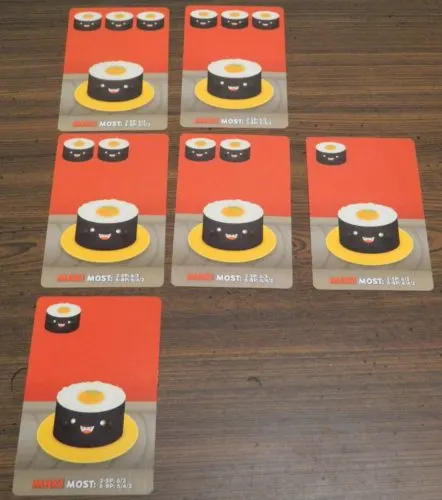
In this round three players acquired maki rolls. The top player acquired six, the middle player acquired five, and the bottom player acquired one. The top player acquired the most so they will score six points. The middle player will score three points.
Temaki
Players are trying to acquire the most temaki throughout the round. The player(s) that collects the most temaki roll cards will score four points. The player(s) that collect the least temaki will lose four points. If multiple players tie for first or last all of the tied players will gain/lose all of the points. In a two player game the player with less temaki will not lose points.
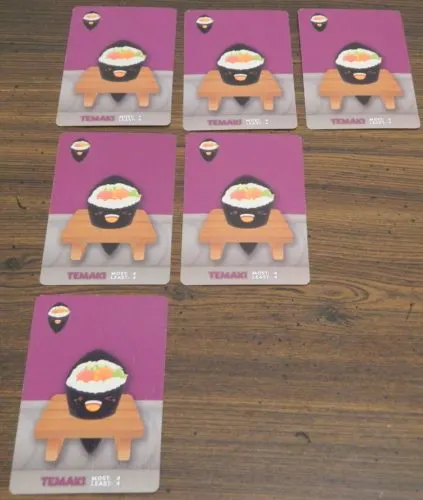
During the round these three players acquired temaki cards. The top player acquired three, the middle player two, and the bottom player one. The top player acquired the most so they will score four points. The bottom player acquired the least so they will lose four points.
Uramaki
Throughout a round players will try to collect ten uramaki icons which are located at the top of the cards. The first player to acquire ten icons will immediately score eight points. They will move their pawn the corresponding number of spaces and then discard the uramaki cards. The next player to acquire ten icons will score five points and the third player will score two points. If two or more players reach ten icons on the same turn the players count up the total number of icons on their cards. The player with more icons takes the higher position. If there is still a tie both players receive the full number of points and the next scoring position is skipped.
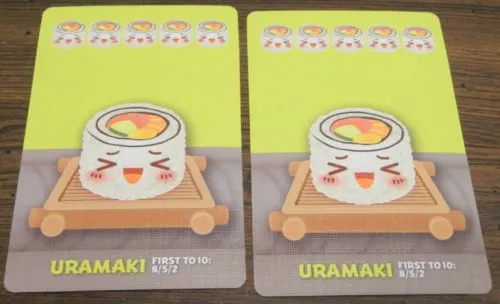
This player has acquired ten uramaki. If they were the first to do so they will score eight points. If they were the second player they will score five points. If they were the third player they will score two points.
If all of the places haven’t been given out during the round the players will count up how many uramaki icons they have in front of them. The player with the most icons will score the highest position remaining. If there is a tie all of the tied players will receive the full reward for the position.
Appetizers
Dumpling
The more dumplings you collect during a round the more points that you will score. You will score points as follows:
- 1 dumpling – 1 points
- 2 dumplings – 3 points
- 3 dumplings – 6 points
- 4 dumplings – 10 points
- 5+ dumplings – 15 points
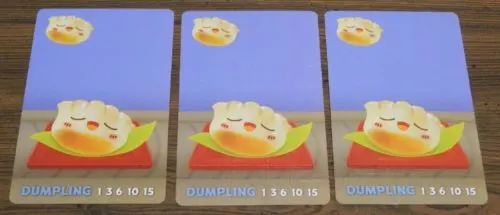
This player collected three dumpling cards during the round. The dumpling cards will score six points.
Edamame
Players will score points from edamame based on how many other players collect edamame cards during the round. Each edamame card is worth one point for each other player that has at least one edamame card. Each card can only be worth a maximum of four points.
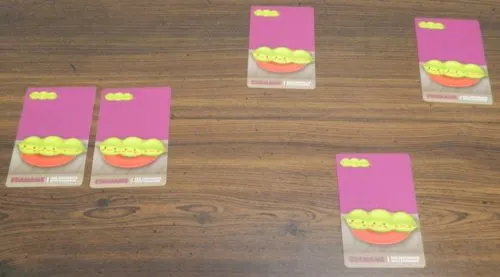
The player on the left collected two edamame during the round. Three other players collected edamame during the round. As four different players collected edamame each edamame card is worth three points. Since the left player collected two edamame they will score six points.
Eel
If a player only collects one eel during the round they will score negative three points. If they collect two or more eels though they will score seven points.

The player on the left only acquired one eel card during the round so they will score negative three points for the card. The player on the right collected two eel cards so they will score seven points.
Miso Soup
Miso soup cards are played differently than most cards. If only one miso soup is played/taken during a turn the player will keep the card in front of them. At the end of the round the card will be worth three points. If more than one miso soup card is played in the same turn though all of them played in the turn will be discarded (will be added back to the game deck at the end of the round), and none of the players will score points. If a player uses a chopsticks, spoon, menu or special order to play a miso soup it will count as being played in the same turn as miso soup cards that are taken normally. Players can score multiple miso soup cards during a round.
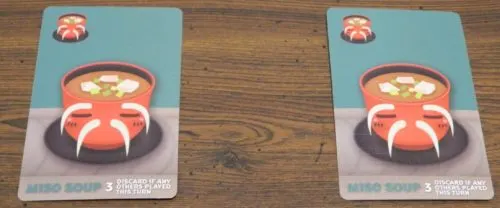
In this turn two players took miso soup cards. Both cards will be discarded and neither player will score points.
Onigiri
There are four different shapes of onigiri. At the end of a round the onigiri will be put into sets with each set only having one of each shape. If a player collects two or more of the same shape they will form multiple sets with each set being scored separately. Each set will be scored based on the number of different shapes in the set.
- One shape: 1 point
- Two shapes: 4 points
- Three shapes: 9 points
- Four shapes: 16 points
Sashimi
If a player only collects one or two sashimi during the round they will score zero points. When a player collects three sashimi in a round they will score ten points. A player can score more than one set of sashimi in a round.
Tempura
Players who only collect one tempura during the round will score zero points from the card. If you collect two tempura cards though you will score five points. You may collect multiple pairs of tempura to score five points for each pair.
Tofu
Players who only collect one tofu during the round will score two points. If you collect two tofu cards you will score six points. Players who collect three or more tofu cards though will score zero points.
Specials
Some of the special cards allow players to take unique actions. As some of these cards may impact one another some of the special cards will have a number in the bottom right corner. This number indicates the order that the card’s abilities will be used. If multiple of these type of cards are used in the same turn the lowest numbered card ability will be performed first followed by the next lowest number and so on.
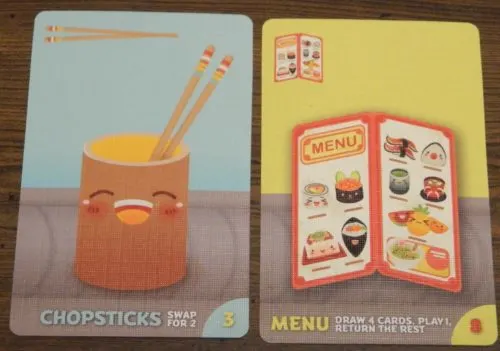
These two cards’ special abilities are being used this turn. As the chopsticks have a lower number their ability will be used first. Then the menu special ability will be used.
Chopsticks
When a player chooses to take the chopsticks card they will place it in front of them like any other card. On a future turn the player can choose to use the chopsticks card in order to take two of the cards from their current hand. You will select your first card like normal. When everyone is turning over their cards you can call out “chopsticks” to take a second card from your hand and place it face up along with the other cards you have taken. The chopsticks card will then be taken from in front of you and added to your current hand. This is all done before players pass their hand to the next player.
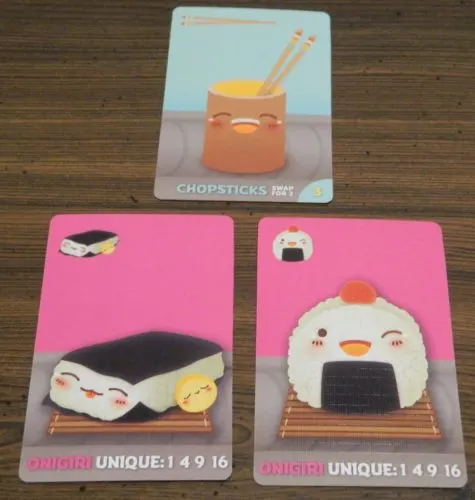
On a previous turn this player took a chopsticks card. On the current turn their hand had two onigiri cards that the player needed. For their normal turn they took the left onigiri. They then used their chopsticks to take the second onigiri card.
At the end of the round a chopsticks card is worth zero points.
Menu
When a player chooses the menu card from their hand they will draw the top four cards from the deck of cards that wasn’t used this round. The player will look through the four cards and choose one that they would like to place in front of themselves. The player cannot choose another menu card. The three cards that the player didn’t choose will be returned to the deck and the deck will be reshuffled. The used menu card will be set aside to be added back into the deck for the next round.
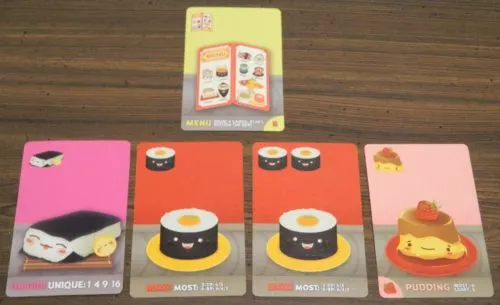
This player used a menu card this turn. They drew the four cards at the bottom. They will choose one of the cards to take while the other three are discarded.
Soy Sauce
At the end of the round all of the players will count up how many different colored backgrounds that the cards they chose have. This includes any soy sauce cards and any dessert cards taken during the current round. If a player that claimed a soy sauce card during the round has the most or is tied for the most different colored backgrounds they will score four points from the soy sauce card. If the player has several soy sauce cards they will score four points for each card.

This player choose a soy sauce card during the round. This player has acquired cards of six different colors. If no other players have acquired more different colors the soy sauce card will be worth four points.
Special Order
A special order card will copy one of the cards that the player has already taken. When a player takes a special order card they will point it towards one of the cards that they have already taken. When the cards are revealed the special order card will be placed on top of the card that it is copying. During scoring the special order card will act like it is the exact card that it is copying. For example if it is copying a three maki roll card the special order card will also be a three maki roll card.
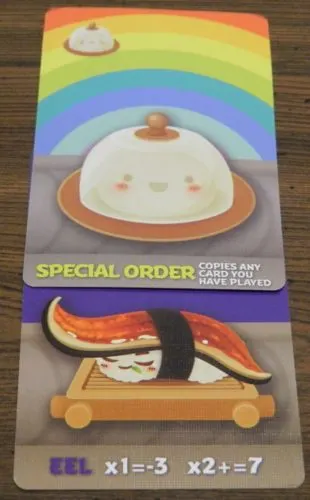
This player decided to make their special order card copy their eel card. The special order card will act as the second eel card needed to make the cards worth seven points.
If a special order card is the first card that a player takes in a round it will have no cards to copy so it will immediately be discarded and reshuffled into the deck at the end of the round.
There are some special rules regarding the special order’s copying ability:
- Nigiri: If you copy a nigiri that is on a wasabi card, the special order will only copy the nigiri. If you copy a nigiri and have a wasabi without a nigiri on it the special order card will be placed on top of the wasabi and the players will have to remember what nigiri it was copying.
- Wasabi: If you copy a wasabi that already has a nigiri on it the special order card will only copy the wasabi. You can place a nigiri card on it on a future turn.
- Miso Soup: If you copy a miso soup and other miso soup cards are played during the turn the special order card will be discarded along with the other miso soup cards played during the turn.
- Uramaki: If the icons copied with the special order card puts you over ten icons you will score the associated points immediately. The special order card and the other uramaki cards will be discarded.
- Special Order: If you copy another special order card it will copy the card that the original special order card was copying.
- Chopsticks or Spoon: If you copy a chopsticks or spoon it will work like a normal card of the associated type. The special order card will have the same turn order number of the card that it is copying.
- Cards Flipped Over By Takeout Box: The special order card will be flipped over as well and count for two points at the end of the round.
- Takeout Box: If you copy a card and then you later flip over the card that the special order was copying, the special order remains the type of card that it was originally copying.
- Desserts: If a special order card copies a dessert it will be set aside for scoring at the end of the game like the other dessert cards.
Spoon
When a player chooses a spoon card they will place it in front of them. On a future turn after everyone has revealed their chosen card the player can call out “spoon”. They will then choose the name of a card that they would like. Starting with the player to their left each player will look for the card in their hand that the player chose. If the player has the card in their hand they must give it to the player with the spoon who will play it in front of themselves immediately. The player will then give the other player the spoon card to replace the card that was taken.
If the player to their left doesn’t have the card the next player clockwise will check their hand. This will continue until one of the players have the chosen card or none of the players have the card. If none of the players have the card the spoon will be discarded (shuffled back into the deck at the end of the round).
If a player chooses not to use a spoon card it will be worth zero points at the end of the round.
When choosing the card that you want you can be as specific as you want. You must choose one type of card. You can be more specific than that though. For example you can ask for just a nigiri or a specific type of nigiri. You could also just ask for maki rolls or a maki roll with a specific number of rolls on the card. If you ask for a more generic card (nigiri/maki roll) the players you ask can choose which one to give you if they have multiple of that type of card. If you ask for a specific type though they can only give you that card if they have it.
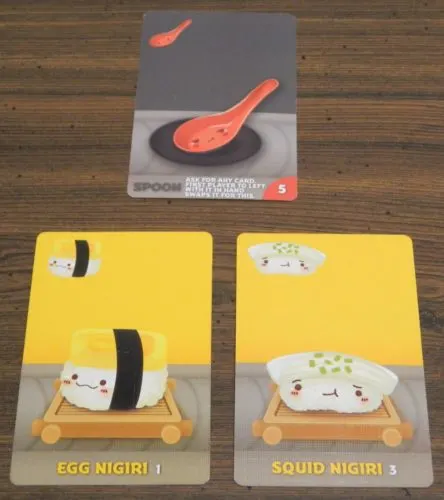
This player has decided to use their spoon card. The player to their left has two nigiri cards. If the player asks for a nigiri card the player can give them either or their nigiri cards. If they specifically ask for a squid nigiri card the player has to give them their squid nigiri card.
Takeout Box
When a player plays a takeout box they will immediately be able to flip over as many of their cards as they want that they took on a previous turn. These cards no longer count as their type of card for end of round scoring. Instead they will be worth two points at the end of the round. The takeout box is then discarded and shuffled back into the deck at the end of the round.
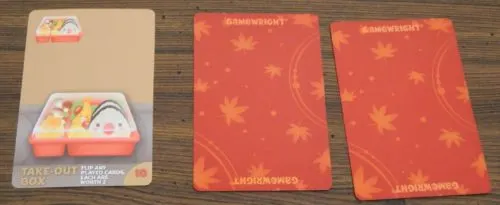
This player chose a take-out box card. They have decided to flip over two of their cards. Each of the flipped over cards will be worth two points at the end of the game.
Tea
Count up the number of cards from the largest set of cards with the same background color. Each tea card will be worth one point for each card in the set.
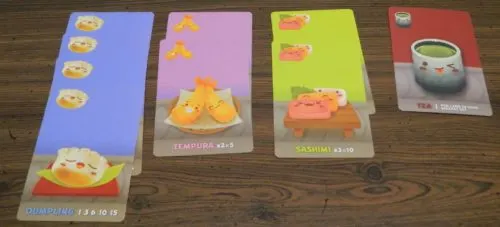
This player’s largest set are the dumpling cards. Since this player acquired four dumplings their tea card will be worth four points.
Wasabi
When a player chooses a wasabi card it will be placed in front of them. This card by itself is worth zero points. The next nigiri card that you play will be placed on the wasabi card. The wasabi card will make this nigiri card worth three times as many points as it would normally be worth. You can only place one nigiri on each wasabi card.
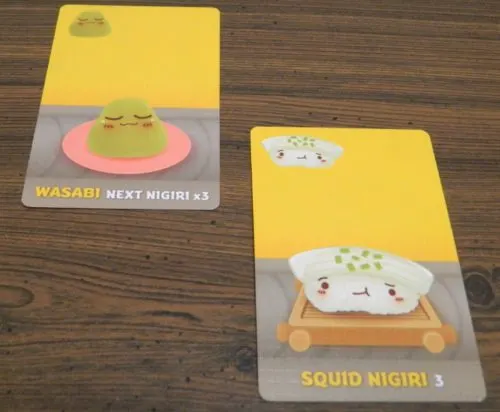
On a previous turn this player acquired a wasabi card. This turn they acquired the squid nigiri. The squid nigiri will be placed on the wasabi. The two cards will be worth nine points (3 x 3) at the end of the game.
Desserts
All dessert cards gathered during a round will be set aside as all desserts are scored at the end of the game.
Fruit
Each fruit card will feature different types of fruits at the top of the card. At the end of the game each player will count up how many watermelon, oranges, and pineapples that they collected throughout the game. They will score points for each fruit based on how many of that type they collected.
- 0 of the fruit: -2 points
- 1 of the fruit: 0 points
- 2 of the fruit: 1 point
- 3 of the fruit: 3 points
- 4 of the fruit: 6 points
- 5+ of the fruit: 10 points
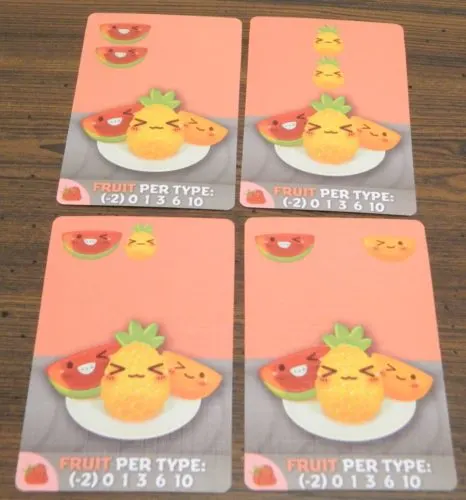
This player collected four fruit cards during the game. The player collected four watermelons so they will score six points for them. The player collected three pineapples so they will score three points for them. Finally they collected one orange so they will score zero points for it.
Green Tea Ice Cream
At the end of the game the players will count up how many green tea ice cream cards they played throughout the game. If a player only collected 0-3 green tea ice cream they will score zero points. If the player collects four cards though they will be worth 12 points. A player can score more than one set of four green tea ice cream cards with each set of four being worth 12 points.
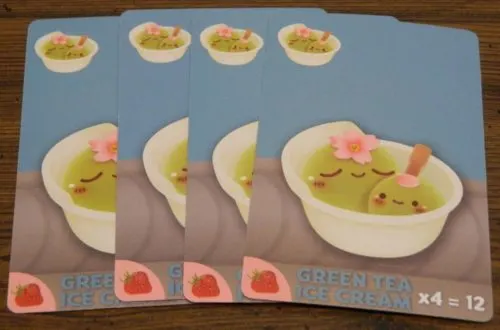
This player collected four green tea ice cream cards in the game. These cards will be worth twelve points.
Pudding
At the end of the game the players will count up how much pudding they played during the game. The player that played the most pudding will score six points. The player that played the least pudding will lose six points. If multiple people tie for the most or least pudding all of the tied players will score/lose the entire six points. In a two player game the player with less pudding will not lose points.
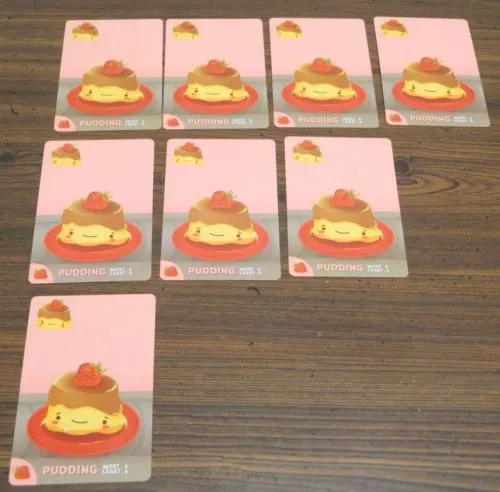
At the end of the game these three players acquired pudding cards. The top player acquired four, the middle player acquired three, and the bottom player acquired one. The top player acquired the most pudding so they will score six points. The bottom player acquired the least so they will lose six points.
End of Game
After three rounds have been played the game will end. The players will finish the scoring for the third round. They will then score the dessert cards collected throughout the game. The player who has scored the most points will win the game. If there is a tie the tied player with the most dessert cards will win the game.
My Thoughts on Sushi Go Party!
As I already reviewed Sushi Go! I am not going to go into great detail about the main gameplay as the two games are basically the same in this area. All of the rules from the original game have been kept the same except for a few tiny tweaks here or there. That is to be expected as the basic mechanics are not complicated and mostly just bring a framework to the gameplay. Where the gameplay really differentiated itself was with the cards. The different abilities/scoring opportunities that came from each type of card is what really drove the gameplay. Each card had its own strengths and weaknesses which allowed you to craft your own strategy as you acquired cards. To win the game you had to somewhat read the other players and try to assemble the best group of cards. The combination of the simplicity and the strategy is what made the original game so enjoyable.
So if the gameplay is basically the same, what is different in Sushi Go Party!? Basically it is what you would get if you took the original game and supersized it. Sushi Go Party! includes all of the cards from the original game and adds plenty more. As a matter of fact the original game had eight different cards while Sushi Go Party! has 23 cards. The sequel has basically tripled the number of cards that you have access to. With the number of new cards in the game you might think the game may become really chaotic. It probably would have except that it introduces one of the main differences from the original game. In the original game you would use the entire deck each game. In Sushi Go Party! you instead choose a menu of cards that you would like to use or create your own set of cards. As the cards have different emphases this adds a really interesting element to the game. The menu you choose can have a pretty big influence on the type of game that you end up playing. You can play with some of the easier cards which makes for a simpler game. You could also choose to play a more laid back game where everyone scores a lot of points or a game that is really cutthroat. This adds a little more setup time to the game, but it is well worth it due to the flexibility and variety the menus add to the game.
As the main addition to Sushi Go Party! are the new cards that the game includes I might as well get to them. I would classify most of the cards into one of two groups. One group is the cards that are quite similar to cards from the original game with a few slight tweaks. The other group includes cards that actually add some interesting new mechanics to the game. I preferred some of the new cards more than others, but for the most part I really liked the new cards. I wish there were a few more cards that added new mechanics to the game, but most of the cards add interesting new decisions to the game. I think the best part of adding so many more cards to the game is that it adds a lot more variety to the game. The original game is great but since you use the same cards for every game it could become a little repetitive after a while. This is no longer an issue for Sushi Go Party! as you can always play a different menu of cards or even create your own menu.
The one concern I had with adding a lot more cards to the original game was that it would make the game more complicated. This is true to a degree but it is not a big issue for the game. Sushi Go Party! is still really accessible like the original game. The main gameplay still takes just a couple minutes to explain to new players. The additional difficulty comes from having to explain how more types of cards work. You only have to teach players about the cards that will be used in the current menu, but whenever you use a new menu you will have to teach the players a few new cards. Most of the cards are around the same difficulty as the cards from the original game. There are a couple cards that are quite a bit more complicated than the original game though. These cards will take a little longer to explain to new players. It might take a little longer to explain the new cards, but like the original game players should adjust to them pretty quickly where they will have a firm grasp on what they are doing after a round or two.
Basically Sushi Go Party! is like the original game but bigger and better. The new cards might slightly tweak the gameplay but at its heart it is still the same game. The game still has the perfect combination between simplicity and strategy. The game is easy to play and yet there is still quite a bit of strategy to it. Basically the key to doing well in Sushi Go Party! is to analyze the cards that are still in play as well as what cards you think the other players will take. You will never have perfect information but once all of the hands have made it to you once you will know what cards are in play. You then have to figure out what cards you think you can get and what cards the other players will take. You will then need to craft the best strategy to maximize your points/minimize your opponents’ points. The game is never going to be as strategic as some games which might turn off some people. I think there is quite a bit of strategy to the game though especially considering the accessibility. Some of the new cards add quite a bit more strategy to the game as well.
I think it has more strategy than the original game, but Sushi Go Party! still relies on around the same amount of luck as the original game. The reliance on luck in the game is different than your typical card game. In the game you don’t really have to rely so much on card draw luck as players will be passing hands. The luck in the game mostly comes from being able to take the best cards from the hands before the other players have the opportunity to take them. While there is some intuition to being able to read the other players and predicting what cards they will take, you are still relying on some luck that they take the cards that you want them to take. If another player takes a card that you need for your strategy there really isn’t anything that you can do. Player positioning can play a pretty big role in the game. The player(s) who sits to the left of the worst player is going to have an advantage in the game as they are more likely to be passed good cards or cards that they need for their strategy.
Like the original game Sushi Go Party!’s components are really good. The card quality is pretty similar to the original game. The artwork is still fantastic and each card does a pretty good job explaining what it does in a clear and precise manner. One of the main additions to the game is the gameboard. The gameboard actually serves two purposes. First it has a score track so players always know where they stand in relation to the other players. The gameboard also has spots where you can place tiles for each of the cards that are in play for the current game. While this adds a little setup to the game, this is a good addition as it gives all of the players a good place to reference the cards that are potentially in play. The gameboard is also quite sturdy and durable. Finally there is the outer tin. For the most part I like the outer tin as it is well made. The only issue is that it is a lot bigger than the box for the original game and is bigger than it needed to be as there is quite a bit of empty space inside.
At this point it will probably already be pretty obvious but Sushi Go Party! is clearly superior to the original game. The original game was great and yet the sequel is still considerably better. Sushi Go Party! takes everything that was good about the original game and makes it better. The game has more cards which leads to more strategy, more variety, and a more satisfactory game. If you want to play the original game you can play it in Sushi Go Party! as well since it includes all of the cards from the original game. The card distribution is slightly different than the original game as you reshuffle after each round, but this doesn’t have a big impact on the game. The main reason why Sushi Go Party! is better is due to the variety of the different menus that you can play which keeps the game fresh. While I own both games and both are great, I honestly don’t know if there really is a reason to buy the original over Sushi Go Party!. The only positives for the original game is that it is cheaper, takes up less space, and the setup is a little shorter. Sushi Go Party! is better in every other way so if you don’t own the original game you are probably better off just buying Sushi Go Party! and skipping the original game altogether.
Should You Buy Sushi Go Party!?
The board game industry doesn’t generally have a lot of sequels like other industries. When there are sequels they basically take the original game and slightly tweak it to sell it as a different game. As I really enjoyed the original Sushi Go! I was curious what its sequel Sushi Go Party! would be like. Basically it is what you would expect from a perfect sequel as it takes everything great about the original game and expands on it to make it even better. The gameplay for the most part is the same as the original game. The game is still easy to play and yet still has quite a bit of strategy as you figure out what cards you should take. The main difference in Sushi Go Party! is that it adds many more types of cards as it almost triples the number of cards from the original game. This adds a lot of variety to the game as players have choices on what cards they would like to use in each game. With the different menus you can choose what type of game that you would like to play from a more laid back game to a cutthroat game. Sushi Go Party! still relies on luck like the original game and isn’t the most strategic game. It is clearly better than the already great original game though as it improves upon the original game in almost every conceivable way.
If you have played the original Sushi Go! and didn’t like it or don’t like these type of card games in general, Sushi Go Party! may not be for you. People that like the original game should pick up the sequel as it is clearly superior. If you have never played the original game but the concept intrigues you I think you will really enjoy the Sushi Go! franchise. I would suggest just skipping the original game though to pick up Sushi Go Party! as it is superior version of the game.

